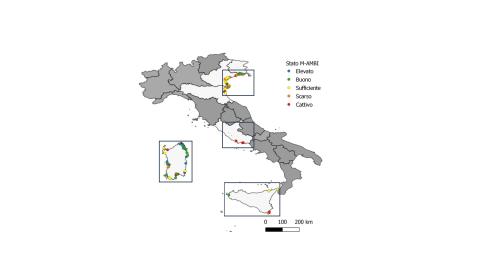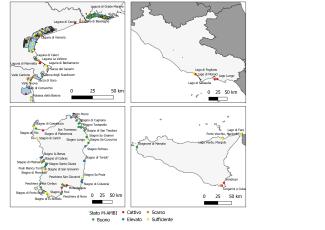Panel 1
Valentina Bernarello, Andrea Bonometto, Rossella Boscolo Brusà, Federica Cacciatore, Federica Oselladore, Emanuele Ponis
The ecological classification index of the Biological Quality Element "macroinvertebrates" for coastal lagoons, M-AMBI (Multivariate-Azti Marine Biotic Index), is based on the analysis of the structure of the macrozoobenthic community in soft sediments. It takes into account species tolerance/sensitivity, community diversity, and species richness. The M-AMBI index responds to anthropogenic pressures affecting transitional areas and describes the ecological quality status in five classes: High, Good, Moderate, Poor, and Bad.
Currently operational monitoring programs in Italian transitional waters include annual sampling on a three-year cycle: as of now, three sampling campaigns have been conducted in almost all regions since 2014. In the 2020-2022 three-year period, of the 92 transitional water bodies where the M-AMBI index was applied, 14.1% are in "High" ecological status, 32.6% in "Good," 21.7% in "Moderate," 16.3% in "Poor," and 15.2% in "Bad." Nationally, for the regions with available data (6 out of 9), 46.7% of transitional water bodies have achieved the quality goal of "Good" or "High."
The M-AMBI (Multivariate-Azti Marine Biotic Index) is a multimetric index that includes the calculation of AMBI, Diversity Index (H), and Species Richness (S). The M-AMBI calculation method involves processing these metrics using multivariate statistical analysis techniques.
This index is used to provide a synthetic ecological classification of the ecosystem through the use of structural parameters (diversity, species richness, and the ratio of tolerant to sensitive species) of the soft sediment macrozoobenthic community. Backed by a robust bibliographic foundation, the M-AMBI is capable of summarizing the complexity of soft sediment communities, enabling an ecological interpretation of the examined ecosystem.
The M-AMBI value ranges between 0 and 1 and corresponds to the Ecological Quality Ratio (EQR) required by the Water Framework Directive 2000/60/EC. The M-AMBI is applied to Mediterranean coastal lagoons (TW).
To classify the quality status of transitional water bodies (coastal lagoons) using the biological quality element "benthic macroinvertebrates."
- Directive 2000/60/EC
- Legislative Decree 152/2006 and amendments
- Decision 2018/229/EU
The Directive 2000/60/EC (transposed into Legislative Decree 152/2006 and its amendments) establishes a regulatory framework for all Member States for the protection of surface freshwater, transitional waters, coastal waters, and groundwater. It aims to improve and restore all natural, artificial, and heavily modified water bodies to achieve good water status within the deadlines set by the current regulations.
The M-AMBI value ranges between 0 and 1 and corresponds to the Ecological Quality Ratio (EQR) required by the Water Framework Directive 2000/60/EC. The class limits for ecological status classification (High, Good, Moderate, Poor, and Bad) are reported in Legislative Decree 152/2006 and its amendments.
Panel 2
Borja, A., Franco, J., Pe´rez, V., 2000. A marine biotic index to establish the ecological quality of soft-bottom benthos within European estuarine and Coastal environments. Marine PollutionBulletin 40 (12), 1100–1114.
Borja, A., Muxika, I., Franco, J., 2003a. The application of a marine biotic index to different impact sources affecting soft-bottom benthic communities along European coasts. Marine Pollution Bulletin 46, 835–845.
Borja, A., Franco, J., Muxika, I., 2003b. Classification tools for marine ecological quality assessment: the usefulness of macrobenthic communities in an area affected by a submarine outfall. ICES CM 2003/Session J-02, Tallinn (Estonia), 24–28 September 2003.
Borja, A., Franco, J., Valencia, V., Bald, J., Muxika, I., Belzunce, M.J., Solaun, O., 2004a. Implementation of the European water framework directive from the Basque country (northern Spain): a methodological approach. Marine Pollution Bulletin 48, 209–218.
Borja, A., Franco, J., Muxika, I., 2004b. The biotic indices and the water framework directive: the required consensus in the new benthic monitoring tools. Marine Pollution Bulletin 48, 405–408.
Muxica, I., Borja, A., Bald, J., 2007. Using historical data, expert judgement and multivariate analysis in assessing reference condition and benthic ecological status, according to the European Framework Directive. Marine Pollution Bulletin 55, 16-29.
Constant updating of the list of species used.
Data quality assessment
ARPA costiere SINTAI
SINTAI https://www.sintai.isprambiente.it/pages/SOE/
National (6/9)
2014-2016; 2017-2019; 2020-2022
Indicator assessment
The M-AMBI (Muxika et al., 2007) includes the calculation of the AMBI (Borja et al., 2000), the Shannon-Wiener Diversity Index H' (1949), and the number of species (S):
- AMBI= [(0 x %GI) + (1.5 x % GII) + (3 x % GIII) + (4.5 x % GIV) + (6 x %GV)]/100
GI: Sensitive species
GII: Sensitive/tolerant species
GIII: Tolerant species
GIV: Opportunistic species (second order)
GV: Opportunistic species (first order)
ss
H' = - ∑ (pi)(log2 pi)
i=1
Where:
- pi = numerical frequency of the i-th species with respect to the total number of individuals = ni/Nn_i / N
- ss = total number of species present at each station
The M-AMBI calculation involves processing these metrics using multivariate statistical analysis techniques. The value of M-AMBI ranges between 0 and 1 and corresponds to the Ecological Quality Ratio (EQR) required by the Directive. The type-specific reference values and class limits are reported in the reference legislation (Legislative Decree 152/2006 and its amendments), which defines 5 classes (High, Good, Moderate, Poor, Bad).
To calculate the index, it is necessary to use free software (AZTI Marine Biotic Index: New Version AMBI 4.1), currently available for download from the website www.azti.es. As it is based on the ecological value assigned to the species present at monitoring stations, the M-AMBI value must be calculated using the latest available update of the species list in the software.
For implementing AZTI's software, an Excel file must be created that lists species in rows and observations (stations) in columns.
The analysis shows that of the 92 Italian transitional water bodies where the M-AMBI index was applied during the 2020-2022 monitoring period (Table 1):
- 14.1% are in "High" ecological status
- 32.6% in "Good"
- 21.7% in "Moderate"
- 16.3% in "Poor"
- 15.2% in "Bad"
Comparing the data with previous monitoring periods reveals an oscillation in the number of water bodies in "Good" and "High" status, ranging from 26.5% to 38.3% from the first to the third monitoring period for tidal water bodies. For non-tidal water bodies, a slight improvement is observed, increasing from 36.9% to 51.8% in "Good" and "High" status over the same periods (Figure 2).
Data
Figure 1b: Application of the M-AMBI index to Italian transitional bodies (zoom on the water bodies of the 6 regions). Triennium of monitoring 2020-2022
Processing by ISPRA in collaboration with ARPA FVG, ARPAV, ARPAE Emilia-Romagna, ARPA Puglia, ARPA Lazio, ARPA Sicilia, ARPA Sardegna based on SINTAI data, coastal ARPA
Figure 2: EQB benthic Macroinvertebrate benthic M-AMBI, ecological quality status of macrozoobenthos in tidal and non-tidal transition waters at national level - Comparison 1st three years (2014-2016), comparison 2nd three-year period (2017-2019) and 3rd three-year period (2020-2022) of monitoring
Processing by ISPRA in collaboration with ARPA FVG, ARPAV, ARPAE Emilia-Romagna, ARPA Puglia, ARPA Lazio, ARPA Sicilia, ARPA Sardegna based on SINTAI data, coastal ARPA
n. CI number Water Bodies
For non-thillary bodies, all data available for three three-yearly monitors were considered.
Table 1: EQB Bentonic Macroinvertestats M-AMBI, ecological quality status of macrozoobenthos in Italian transitional waters at regional and overall level
Processing by ISPRA in collaboration with ARPA FVG, ARPAV, ARPAE Emilia-Romagna, ARPA Puglia, ARPA Lazio, ARPA Sicilia, ARPA Sardegna based on SINTAI data, coastal ARPA
No. CI number Water Bodies
Table 2: EQB Macroinverte Bentonici M-AMBI, state of ecological quality of macrozoobenthos in Italian transitional waters grouped by type "tidal/non-tidale" in the three-yearly monitoring - 1st three-year period (2014-2016), 2nd three-year period (2017-2019) and 3rd three-year period (2020-2022)
Processing by ISPRA in collaboration with ARPA FVG, ARPAV, ARPAE Emilia-Romagna, ARPA Puglia, ARPA Lazio, ARPA Sicilia, ARPA Sardegna based on SINTAI data, coastal ARPA
No. CI number Water Bodies
For non-thillary bodies, all data available for three three-yearly monitors were considered.



The application of the M-AMBI index in national transitional waters provides a general assessment of the macrozoobenthic component for regions with available data (6 out of 9), encompassing a total of 92 water bodies (Figure 1a - 1b). Transitional waters classified as "river mouths" were excluded from the count and analysis, as the indicator is currently not applicable to them. Nationally, data from the 2020-2022 period show that 46.7% of transitional water bodies have achieved the quality target ("Good" or "High").
At the regional level (Table 1), the quality target was achieved by:
During the 2020-2022 period, Campania and Puglia did not apply the M-AMBI index for benthic macroinvertebrates.
When grouping water bodies by "tidal/non-tidal" category (Table 2, Figure 2), the data show that: